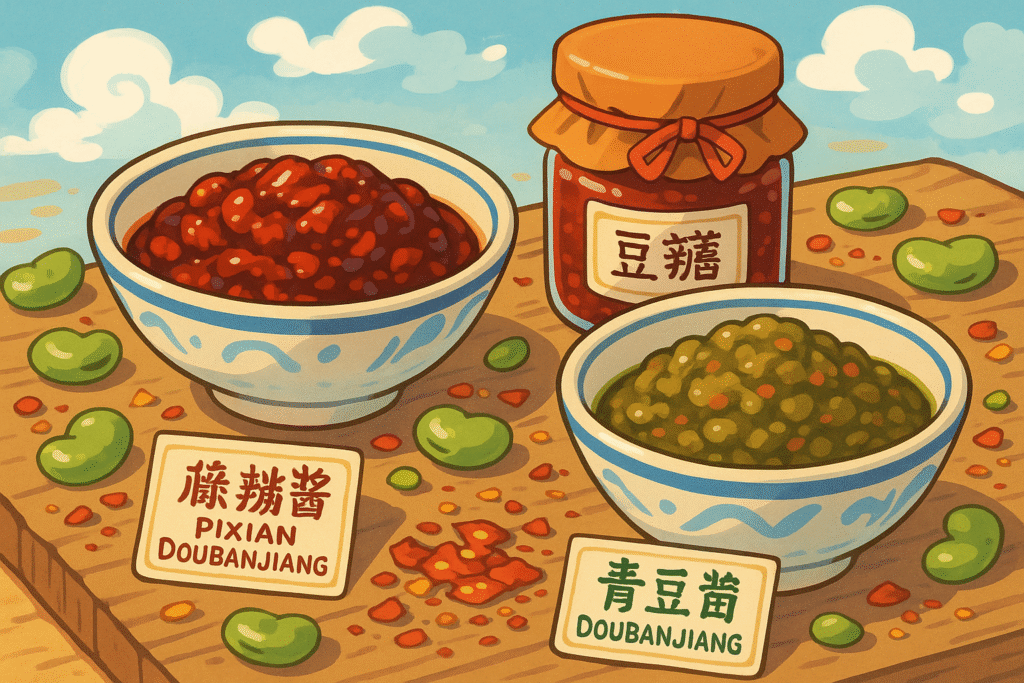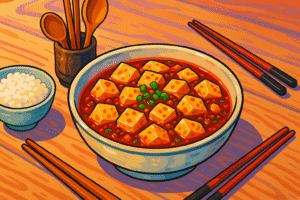Doubanjiang ()

About Doubanjiang
Doubanjiang (豆瓣酱), pronounced “doh-bahn-jee-ang,” is a bold, spicy-salty paste made from fermented broad beans (Vicia faba), chili peppers, salt, and sometimes wheat flour.
Typically it comes as a deep red paste with an intensely aromatic and umami flavor. It’s a great combination of savory and fiery tastes, with a funk reminiscent of miso but much more spicy.
If you’ve tried any dishes from the Sichuan region of china, you’ve likely tried it before. It’s the backbone of iconic Chinese dishes such as mapo tofu and twice-cooked pork, lending them their signature color, flavor, and depth. As such, it’s often called the “soul of Sichuan cuisine.”
However, don’t be fooled. Doubanjiang is far from a one-note condiment: it transforms with long fermentation, becoming more nuanced, earthy, and robust with age. No two brands or makes of Doubanjiang are the same. And there’s even a range of different Doubanjiang varieties, suited to specific dishes, regions or personal tastes.
The History of Doubanjiang
Doubanjiang emerged from China’s Sichuan province, with production estimated to date back over 300 years, though bean-based ferments have older origins. Legend ties the most revered doubanjiang to Pixian, a town near Chengdu, where families still craft it using traditional clay pots set outdoors to age.
This condiment was originally prized for its abilities to preserve beans and chilis, and quickly became celebrated in local cuisine for its flavor-boosting power. Over time, doubanjiang’s fame spread beyond Sichuan, adapted in neighboring regions like Hunan, but it remains deeply rooted in Sichuan’s culinary DNA. Every Sichuan kitchen and many professional chefs consider a jar of doubanjiang indispensable, attributing it almost mythical significance in their dishes.
The Science of Doubanjiang
Fermentation sits at the heart of doubanjiang’s complexity. After broad beans are cooked and mixed with chillis, salt, and occasionally wheat flour, the mixture is inoculated with environmental molds and bacteria. A lengthy fermentation period — at least several months, often years — unleashes enzymes that break down proteins in the beans, releasing free amino acids such as glutamate, responsible for the coveted umami punch. Meanwhile, lactic acid bacteria contribute tang, and various yeasts and molds generate aromatic compounds, spicy undertones, and a mellow backbone. Doubanjiang is high in protein, low in fat, and rich in capsaicin from the chilis, offering trace minerals and antioxidants typical of fermented foods.
The Geography of Doubanjiang
Doubanjiang is most famously made in Pixian (郫县), located just northwest of Chengdu in Sichuan Province, where it benefits from humid, subtropical conditions ideal for natural fermentation. Here, family-run producers age the paste in open-air clay urns, developing more complex flavors from local microflora. The nearby towns of Chongqing and Leshan also create regional takes — hotter, sweeter, or with a different textural bite, depending on the proportion of beans, chilis, and other additions. Outside Sichuan, similar broad bean chili pastes are produced, but Pixian doubanjiang is revered nationwide as the gold standard and the benchmark found in professional Sichuan kitchens.
Varieties of Doubanjiang
Pixian Doubanjiang (郫县豆瓣酱)
The archetype. Rich, chunky, deep crimson, and full-bodied with prominent umami and steadily building chili heat. Essential for Sichuan dishes like mapo tofu; often aged for multiple years.
Qingdou Doubanjiang (青豆豆瓣酱)
Made from green broad beans instead of the usual mature beans, resulting in a lighter color and slightly fresher, more vegetal flavor. Found in some regions of Sichuan and used in lighter braises.
Minced Doubanjiang
A smoother, more finely ground paste for cooks who want an even, silky texture in sauces or marinades. Used when blending into dressings or achieving a homogenous consistency in stews.
Hunan-style Chili Bean Paste (剁椒豆瓣酱)
A cousin from neighboring Hunan province, this version is spicier, saltier, and often includes garlic or ginger, designed to complement the region’s preference for heat and pungency in food.
Top Dishes Containing Doubanjiang
FAQs All your questions about Doubanjiang: answered
What’s the difference between doubanjiang and gochujang (Korean chili paste)?
Doubanjiang is made from broad beans and chilis, with a savory, salty, chunky texture and strong fermented character. Gochujang uses glutinous rice, soybeans, and more sugar — resulting in a sweeter flavor and smoother, more paste-like texture.
How spicy is doubanjiang?
Spice levels vary by brand and variety. Most Pixian doubanjiang brings a steady, moderate chili heat balanced by rich umami, though some local batches (or Hunan versions) can be quite fiery. Always taste before using generously.
Can I substitute miso or other bean pastes for doubanjiang?
No true substitute matches doubanjiang’s combination of spice, salt, and funk. Miso, fermented bean pastes, or chili pastes can provide some savory notes or heat, but the depth and complexity will differ.
Does doubanjiang need to be refrigerated after opening?
Yes, for best quality. Refrigeration helps preserve freshness, color, and flavor, though the high salt content naturally extends its shelf life.
What dishes can I use doubanjiang in?
It’s essential in Sichuan dishes like mapo tofu, shuizhu (water-boiled fish or beef), and stir-fried green beans. It can also be blended into marinades, soups, or used as a base for spicy dressings and hotpot broths.
